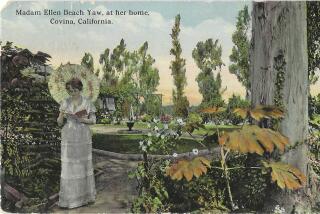Appreciation: Doris Day, a life in 10 songs
- Share via
Doris Day, who died May 13 at the age of 97, was one of the great voices of the 20th century, though, as with her acting, the apparent ease with which she performed could hide that fact.
Day began, still in her teens, as a big-band singer before moving inevitably into movies. Pure and perfectly pitched, informal and intimate, with every consonant and vowel present and accounted for, her voice was a great instrument of communication.
Like her contemporary Judy Garland — they were born months apart, in 1922 — Day was casually modern, always real and completely present; their work doesn’t date, even if the pictures and songs and arrangements do.
Unlike Garland, there was nothing fragile about her: Day’s real romantic life was marked by some bad choices, but even in her songs of longing and disappointment, one feels that things will turn out well, eventually. And, seemingly, on her own terms, they did.
What follows is a look at a singer’s life, as lived in music.
Doris Day: A guileless natural on screen and record, and a mystery even to her devotees »

1) “Whatever Will Be, Will Be (Que Sera, Sera).” Day’s signature song (supplanting earlier signature songs). A faux folk waltz in an Italianate manner, from the team of Jay Livingston and Ray Evans (“Mona Lisa,” “Tammy). Dean Martin’s “That’s Amore” had come out a few years before; it was a going style at the time. It was originally sung, to solo piano accompaniment, during a key, tense scene in Alfred Hitchcock’s 1956 remake of “The Man Who Knew Too Much,” in which Day starred opposite James Stewart; it won the best song Oscar for its year. The single version, tricked up with Mediterranean mandolin, is a merrier event. Day revisited it briefly in two subsequent films, “Please Don’t Eat the Daisies” (1960) and “The Glass Bottom Boat” (1966).
2) “Sentimental Journey,” Day’s first signature song, recorded in 1945, at the age of 23, with Les Brown and His Band of Renown (Brown wrote it with Ben Homer and Bud Green). Loping saxophones lead this easygoing chart, Day’s first No. 1 single, slight twang. Day, who discovered she could sing by singing along with the radio, was an avowed fan of Ella Fitzgerald, and one hears both Fitzgerald’s precision and her winsomeness in this performance; but there might be a little Billie Holiday in there too. As always, the singer’s consonants are present and accounted for. Her approach is conversational and confidential, but when she opens up on the bridge -- “Seven, that’s the time we’re leaving” — a star is born.
3) “It’s Magic.” This cascading ballad, which starts high and collapses into sighs on the title refrain, is her second signature song. It comes from the 1948 comedy “Romance on the High Seas,” Day’s first film, in which she played a spunky, hip chick with a penchant for jazz jive. She’s the secondary romantic figure, but if this movie has any lasting importance, it’s everything she does in it — she wasn’t sure she could act, but, as in her singing, honest interpretation is her strong suit.
4) “Put ‘em in a Box, Tie ‘em with a Ribbon, and Throw ‘em in the Deep Blue Sea.” Also from “Romance on the High Seas,” this song, written by Jules Style and Sammy Cahn, teamed Day with the light bop of the Page Cavanaugh Trio, with whom she would record occasionally over the next few years. Its light swing and devil-may-care lyric fits her well; though Day would acquire the image of a perennial, ironically virginal housewife, she grew up, not always pleasantly, among jazz musicians from her teens (and married two), and knew how to handle herself, both on and off the mike.
5) “Let’s Take an Old-Fashioned Walk” (with Frank Sinatra). Day would later co-star with Frank Sinatra in the 1955 musical drama “Young at Heart,” when Sinatra was already becoming the existential antihero of American pop songs. Here, in a 1949 recording of an Irving Berlin song, written the same year but focusing on pleasures of the past (see “By the Light of the Silvery Moon,” below), he is still the Sinatra who could pull off playing innocent juveniles in Gene Kelly pictures; both singers bring the antique fun to this high-kicking waltz, amplified by a comical spoken prologue.
6) “By the Light of the Silvery Moon.” Day co-starred with Gordon MacRae in five features for Warner Bros., mostly period musicals that took advantage of the company’s deep well of songs — they were the equivalent of today’s jukebox musicals — and added to Day’s recorded corpus a lot of songs that were old-fashioned at the time but reworked for her style. She and MacRae had a lovely, flirty, parlor-romance interplay; onscreen, in the 1953 musical the song gave a name, they sing “By the Light of the Silvery Moon” side by side at the piano, but the soundtrack recording, for whatever, probably contractual reason, features Day alone.
7) “Secret Love,” from the 1953 frontier musical “Calamity Jane,” written by Sammy Fain and Paul Francis Webster, is another of the songs most identified with Day, a chart-topping single and her first Oscar winner. A lilting, then soaring ballad – “lilting, then soaring” being something of a specialty with this singer – it floats on a bed of harp, strings and winds and comes at what, to a present-day viewer can feel like a disappointing moment: Calamity’s conversion from scruffy independent wildcat to something approximating “wife material.” (Howard Keel’s Bill Hicock is the secret love who’s no secret anymore.) It’s not as bad as that, in the end – she’s still packing a six-shooter beneath her wedding dress.
8) “Nobody’s Heart.” From “Duet,” a 1962 album recorded with the Andre Previn Trio; this album, which brought out the jazz in Day’s singing, is the sort of thing one wishes she would have done more often; her recordings of the time were characterized by big orchestras and string-soaked arrangements that, while not drowning the singer completely in schmaltz, were something to work against more than work with. Here, with only Previn’s piano, Red Mitchell’s bass and Frank Capp’s drums to accompany her, the song’s the thing; every track is a gem, but this pensive reading of a bravely melancholy Rodgers and Hart ballad stands out for me.

9) “Night Life.” The Willie Nelson ballad was a hit for Ray Price in 1963, the same year Day recorded it for her album “Love Him.” The lyrics (“The night life / Ain’t no good life / But it’s my life”) are darker than is typical for Day, but she gives it a lived-in reading. (A slightly bizarre spoken preamble to a jittery “city music” orchestral accompaniment precedes the song proper.) Day was over 40 now, and there was a natural ripeness to her voice.
10) “Daydream,” written by John Sebastian for The Lovin’ Spoonful, is one of the rare rock-era songs Day recorded; it comes from a cache of 1980s recordings produced by her son, Terry Melcher, some of which provided background music for her cable pet show “Doris Day’s Best Friends” and was eventually released on the 2011 odds and ends album “My Heart.” Day’s voice is markedly lower here – she effectively stopped recording new music in the 1960s – but the ambling, happy nature of the song suits her well.
Follow Robert Lloyd on Twitter @LATimesTVLloyd
More to Read
The biggest entertainment stories
Get our big stories about Hollywood, film, television, music, arts, culture and more right in your inbox as soon as they publish.
You may occasionally receive promotional content from the Los Angeles Times.











